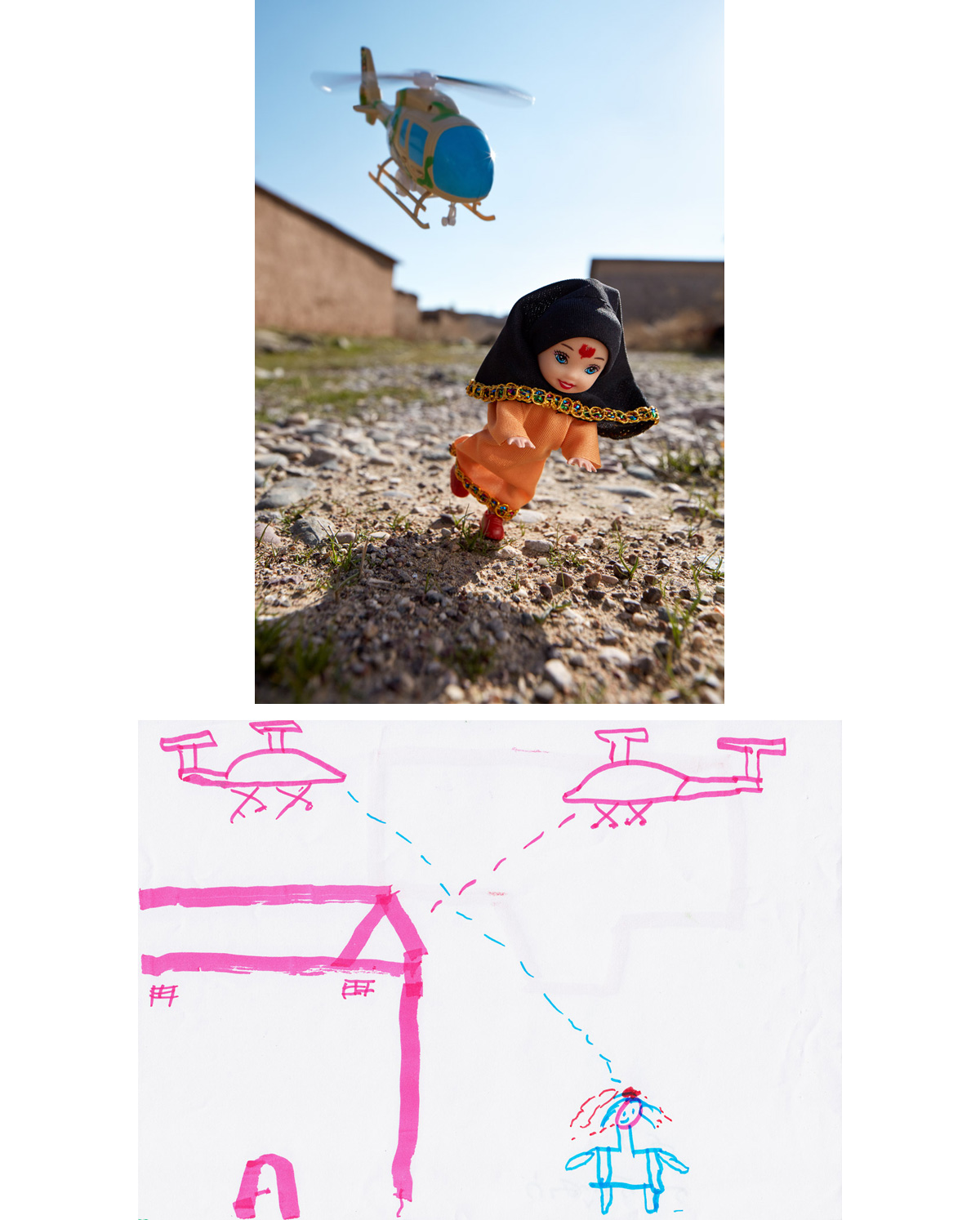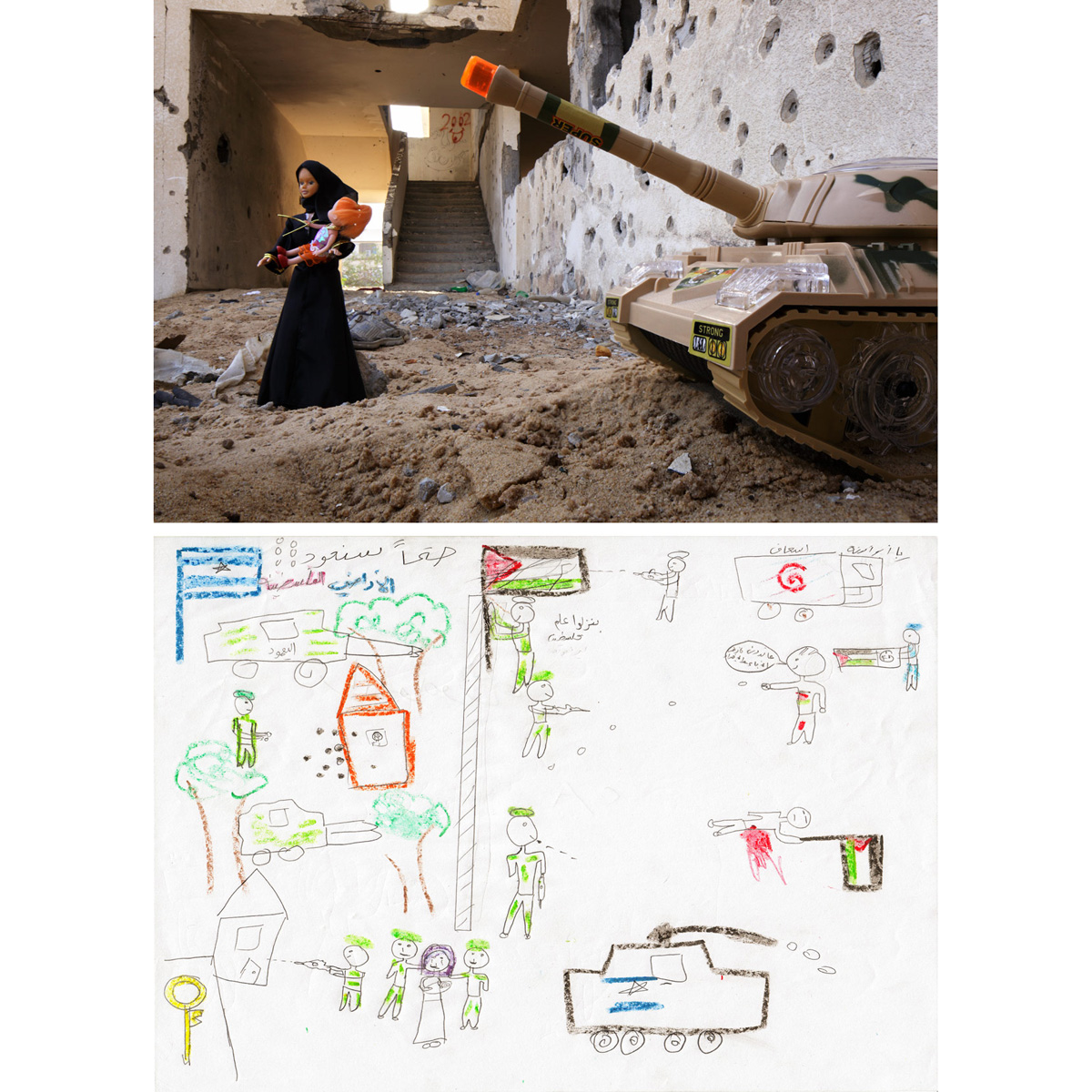Homecoming
Old City of Mosul, Iraq
2018
At a child friendly space in the Debaga IDP Camp in Iraq, Hussein made a drawing showing he and his parents returning home, yet even at this hopeful event, a helicopter can be seen shooting at them from above. As he waited to show the art therapist his drawing, Hussein filled the blank spaces on his page by practicing the English letters he had been learning. A set of secondhand wooden toys were found in a bin at the Langa Bazaar in Erbil. The figures looked like they once belonged to a puzzle for a young child, one where each family member had a place where they fit, perhaps within a house. They were taken to the remains of the Old City in West Mosul, and Hussein’s imagined homecoming was photographed within the current reality, still littered with corpses and explosive hazards.
Suicide Car Bomber
East Mosul, Iraq
2017
Inside the Hassansham IDP Camp, at a Child Friendly Space provided by TdH Italia and UNICEF, a young girl named “Shadiya” made a drawing of what she said was a Daesh soldier placing a bomb onto a car. She then violently filled the page with orange and yellow scribbles that covered the vehicle and figure, showing an explosion. Days later, the girl’s account was recreated in East Mosul using locally found toys that were placed, posed, and set ablaze in shards of glass from a building destroyed by a suicide car bomber. A young militant, not too much older than other children in the camp, had driven a car loaded with explosives into the frontlines of Iraqi forces trying to retake the city from ISIS.
Survivor. Alone.
Bekaa Valley, Lebanon
2016
An anonymous Syrian refugee girl revealed her feelings of intense isolation and guilt over surviving an airstrike that killed the rest of her family in Aleppo. In an art-based interview at a Kayany Foundation school located within her camp near the Lebanon-Syria border, she drew herself crying in a field of ash, protected by an invisible shield from the missiles falling above. Note that the girl’s name has been pixelated on the top right of her drawing to preserve anonymity.
Sderot Home
Sderot, Israel
2012
When interviewed, “Uri” had been living in Sderot Community Shelter #36 for more than a week. His drawing was made on the morning of 22 November 2012 in the first few hours of a ceasefire that ended “Operation Pillar of Defense.” During the relatively brief escalation of the longstanding Israeli-Palestinian conflict, Israeli forces destroyed approximately 1500 targets within Gaza, and militants within Gaza fired 1456 rockets and mortars into Israel, many landing in or nearby the town of Sderot. The town with its close proximity to Gaza is a frequent target, so much so that a network of underground community bunkers protects Israeli citizens. Uri drew about the seemingly countless rockets that he imagined falling on his home. Many other children created drawings with similar themes.
Crazy Tank
Qayyarah, Iraq
2017
In a recently reopened school in Qayyarah, Iraq, “Mas’ud” created a very direct drawing showing what he said was a tank killing Daesh (ISIS). The town had been under ISIS control for two years and only just liberated. A plastic solider and electronic tank purchased nearby were photographed in the burning oil fields on the outskirts of town, next to tank tracks left during the fight over the territory. The area around the burning wells was heavily littered with mines, greatly complicating efforts to extinguish the blazes. The smoke that loomed over the city helped feed the lingering fears of Mas’ud and the other children in town.
Wall Shooting
Israeli Separation Barrier, West Bank
2011
Several Palestinian children in East Jerusalem and the Dheisheh Refugee Camp near Bethlehem made similar drawings of people being shot near the Israeli Separation Barrier. The controversial wall was a potent symbol and source of anxiety for most of the boys and girls. This account was shared by 11-year-old “Walid” and shows his friend who was killed by a soldier in unknown circumstances. Walid labeled him in Arabic as a “martyr” before placing a large “X” across the scene. The photo was created a short distance from the Kalandia Checkpoint on the road to Ramallah, coincidentally during one of the frequent, violent clashes between protestors and soldiers.
Refugee Camp Life
Informal Syrian Refugee Camp, Bekaa Valley, Lebanon
2014
With “I love Syria” written in Arabic on the right side of her drawing, “Hadil” showed her life before the war, her dad in front of their home watering a tree. On the left, she drew the refugee tent she was now living in with her brother and sister. Her father is notably absent as the children carry their possessions. Hadil said that she hated the cold rains that had come that winter. Several young Syrian refugees who had recently arrived in Lebanon made similar drawings about adjusting to the harsh conditions within their informal encampment near the border. The toy figures, sourced from a close-by shop, were photographed within Hadil’s camp.
Elephants
West Mosul, Iraq
2018
Ahmad made a drawing he labeled as “a huge elephant and its [family] members” during an art-based interview with Myra Saad inside the Debaga IDP camp in Iraq. When Myra spoke with him about it, she asked about the one elephant that only had an outline. He said very intently that he didn’t want to color that one in. It was the ghost of a dead sibling, gone but still felt. The toy elephants were photographed in Mosul at the base of the al-Hadba’ ("hunchback”) Minaret, built in the 12th century and destroyed by ISIS in 2017 in the final days of the battle for the city.
Gunned Down
Hassansham, Iraq
2017
At a child friendly space run by TdH Italia inside the Debaga IDP Camp in Northern Iraq, a young boy named Uday drew about a helicopter very specifically shooting a girl in the head. He didn’t want to share any more details about the event or other elements in the drawing with Art Therapist Myra Saad, but it is likely a representation of how his sister died. The toy doll and helicopter were found nearby, inside the Central Bazaar in Erbil.
Youth Resistance
Dheisheh Refugee Camp, West Bank
2011
“Asim” dreamed of a youth resistance led by older peers to stop Israeli incursions into his camp outside of Bethlehem in the West Bank. He made an elaborate drawing showing groups of young refugees throwing stones at soldiers, tanks, and other vehicles. The mural in the background of the resulting photo is of 17-year-old camp martyr Qusai Alafandi. He was killed on 28 January 2008 after throwing a Molotov cocktail at Israeli Defense Forces inside the Dheisheh Refugee Camp.
Crossing An ISIS Checkpoint
Hassansham, Iraq
2017
To return home to Zumar, a boy named Salaam and his family had to cross through a checkpoint controlled by the Islamic State. There, he saw ISIS soldiers shooting people. The memory of what he saw from the car window haunted him still.
Oil Field Showdown
Qayyarah, Iraq
2017
Just outside the town of Qayyarah, oil fields were set ablaze by Islamic State fighters as they left anti-tank and anti-personnel mines to halt the advance of Iraqi forces to nearby Mosul. The thick black smoke hung over neighborhoods that bore the scars of heavy combat, reminding children of the two years of ISIS-occupation they had endured. In an art-based interview organized by IOM at a recently reopened school, Assem created a drawing showing the battle for the town. Because of the explosive hazards in the area, extra care was taken while recreating his account within the oil fields.
Armless Body
West Mosul, Iraq
2018
“When people started fleeing, my mom told my sister and me to go get the rest of the family. We went out of our street and there was an Islamic State fighter lying there. His stomach was detached and his arms were dismembered next to him.” (translated from a Reuters interview with Saja Ibrahim on 8 July 2018 at a TdH Italia CFS in Debaga, Iraq).
Saja shared her story in an art-based interview conducted by Myra Saad in May 2018 at the Debaga IDP Camp in Iraq. The toys were a combination of secondhand dolls found in the Langa Bazaar in Erbil and a new action figure, bought in the Central Bazaar then modified. As the photo was shot in Mosul’s Old City, crews of young men were sifting through the rubble, pulling out scrap metal and unearthing the bodies of fighters and civilians that remained.
Mother of Violence
Northern Gaza Strip
2012
A bootleg Fulla doll holds a generic plastic girl that can be found in most warzones and dollar stores alike. The photo is based on a drawing by “Karima,” a Palestinian girl attending an UNRWA-run elementary school in Gaza City. A large number of children created drawings that were similar to Karima’s. There is recurring iconography – olive trees, keys, flags, walls – that symbolize deeply held beliefs and issues at the heart of the Israeli-Palestinian conflict. However, the truly common thread seen from children, regardless of the conflict, is the de-emphasis of important, personal elements inside of their drawings. Hiding within Karima’s chaotic scene is a mother holding a child, afraid of the fighting.
Burning Neighborhood
Bekaa Valley, Lebanon
2016
At the Kayany Foundation’s Malala Yousafzai School, located adjacent to an informal Syrian refugee camp in Lebanon, 13-year-old “Fatima” made a before-and-after drawing of her home. Talking about it, she said how peaceful and beautiful the neighborhood had been before the war destroyed it all. She wondered if she would see any of her neighbors again, or if they had even survived.
War Family
East Mosul, Iraq
2017
Noor’s account of her family fleeing Mosul was recreated in a newly liberated section of the city while fighting raged on less than kilometer away. In her drawing, she made no distinction between IS and US-backed Iraqi forces. Both were equal threats to her. Noor was one of an estimated 950,000 people displaced from their homes in Mosul and forced to cross frontlines to reach safety. The plastic family, soldiers, and vehicles were found in local bazaars and photographed underneath an ISIS billboard (top left) and against graffiti proclaiming that the Islamic State was never leaving.
Night Escape
Outskirts of Mosul, Iraq
2017
Similar accounts were shared again-and-again, across multiple groups in four IDP camps near Mosul – children fleeing their homes in the middle of the night to escape ISIS-controlled territory. Most had to sneak past soldiers and checkpoints with their families. Some had been shot at when spotted. A few had seen people killed around them and bodies of other attempted escapees lining the routes out. In their drawings, girls and boys often included the moon alongside an aircraft, both looking down, unable or unwilling to intervene.
For more information, please visit the War Toys organization’s website at wartoys.org
Note: To preserve some children’s anonymity, identifying information has been pixelated in their drawings and names appearing in quotes have been changed.

















